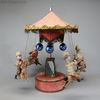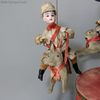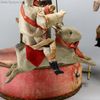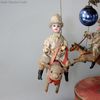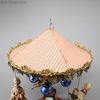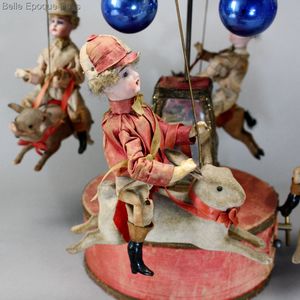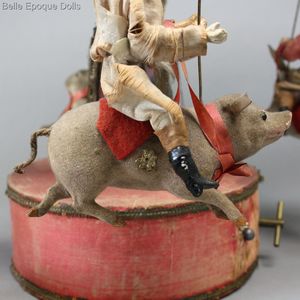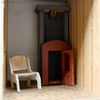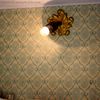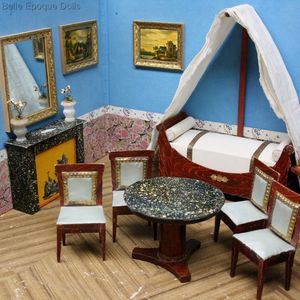A rare cardboard and paper folding French bedroom, the three walls with original light blue wallpaper above the dado, pink, green and black marbleized paper below, wooden frames enhanced with Dresden paper and varnished engravings, streaked beige floor with folding extension.
The wooden and cardboard furniture are painted to simulate mahogany, decorated with embossed gilt paper, the tops painted to simulate marble, the lit en bateau with original white cotton bedding and white muslin hangings. They are characteristic of the furniture produced in France between 1815 and 1830, the period of the restoration of the monarchy after the defeat of Napoleon I and the end of the Empire.
Room 16 1/2"(42 cm) wide, 10 "(25.3 cm) high and 15 1/4"(38.7 cm) deep. Chairs are 3 3/8"(8.7 cm) high. Bed is 4 7/8"(12.3 cm) long.
The lamp is very interesting. This lamp model, known as Astral Lamp, was created by Bordier-Marcet in 1809-1810 (source : Les Merveilles de la science/L’art de l’Éclairage - by Louis Figuier - 1870). See pictures. The astral lamps were gradually supplemented by the Sinombre lamps from 1820.
Given some similarities with rooms attributed to Louis Badeuille (general room design, marbled base of the walls, flower pots, black paper simulating marble top of furnishings) this room may be attributed to Joseph Riolet (see more information below).
France - Circa 1825-1830.
Very good to excellent condition. Wear on the floor. Furnishings very well protected in the box. The box itself is in very good condition.
Value point : extremely rare original room from this period - Museum piece.
* * *
Joseph Riolet was born in 1787, two years before the French Revolution. In 1823 he founded his business in Paris, at 2 rue Molay. In 1828, his activity was described in the Répertoire du Commerce de Paris, a professional directory:
Manufacturer of small children’s furniture, such as armchairs and sofas covered in canvas and satins, of all sizes, with or without ornaments.
His business was quite small, as he shared 2 rue Molay with other entrepreneurs. Joseph Riolet married Claude Paturot, with whom he had several children. His sons all worked in the woodworking trades. They appear in business directories as tabletiers.
The tabletier uses ivory and all rare species of wood that come from foreign countries such as boxwood, ebony, walnut, cherry, olive. He makes games of chess, tric-trac, checkers, and an infinity of small wooden works. In the eighteenth and nineteenth centuries, especially under the First Empire, tabletiers knew a golden age thanks to the vogue of travel necessaires, boxes where meticulously fit a large number of objects from the production of tabletiers (source: Wikipedia). One of Joseph Riolet’s sons filed a patent for a machine to cut precious wood into thin plates.
Joseph Riolet also had a daughter Anne-Apoline, born in 1807, who married in 1830, Denis Badeuille from Aire-sur-la-Lys, in Northern France. On her death certificate, in 1888, Anne-Apoline appeared as a toy worker; she therefore worked all her life in the family business.
In 1840, Joseph Riolet appeared in directories at a new address, 13 rue Notre-Dame de Nazareth, still in Paris. From 1845, the activity was shared with his genus Denis Badeuille, who appeared alone in professional directories from 1848.
Joseph Riolet died in 1858.















